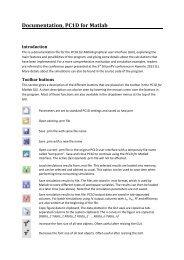Download
Download
Download
You also want an ePaper? Increase the reach of your titles
YUMPU automatically turns print PDFs into web optimized ePapers that Google loves.
AR in architectural and urban planning.<br />
søren s. sørensen, architect / assistant professor<br />
the oslo school of architecture and design, norway.
AHO<br />
aho is an independent higher education institution within<br />
the Norwegian university system<br />
and one of the leading schools and research centres in<br />
the fields of architecture and urbanism in Scandinavia.
Architectural practice<br />
Urban planning and the design of large scale architectural<br />
projects today utilise traditional techniques as projections,<br />
perspectives, 2D data and 3D physical and digital models.<br />
These embody both the need for abstraction and<br />
interpretation and thus the subject matter is difficult to<br />
understand and can mislead those not trained in the field.
prevailing view on representation:<br />
...the notion or understanding<br />
that value-neutral representations as<br />
plan, section and details collectively<br />
constitutes the total idea ...
Current representation of the man-made environment:<br />
• Two dimensional: plans, sections, elevations<br />
• Three dimensional: sketches, perspectives, models, virtual reality.<br />
The limitation of these types of representations is that viewers are<br />
always positioned outside the representation, they remain spectators<br />
rather than participants.
- one still has the problem of understanding space<br />
and the scale of proposed projects.<br />
interactive digital models can give a solution to this...
Sensorama Simulator,<br />
US Patent #3,050,870, 1962<br />
1963: I. Sutherland's doctoral theses: Sketchpad.<br />
stereo HMD/ position tracking/ graphics engine.<br />
1966: T. Furness: display systems for pilots<br />
1967: Brooks: GROPE force feedback system<br />
1977: Sandin and Sayre: bendsensing glove<br />
1979: Raab et al: Polhemus tracking system<br />
1989: Jaron Lanier coins the term virtual reality<br />
1994: VR Society formed etc…
In a VR model all parts of a scene has to be digitally constructed,<br />
which requires extensive work for the making of the model and<br />
highly specified and expensive hardware for the regeneration of<br />
them.<br />
Orientation in a VR model is not intuitive, the feeling of presence is<br />
hard to achieve and the problem of scale is still not solved in<br />
screen based systems.<br />
That is, even though one moves through digital models that closely<br />
resembles a reality, it is experienced as a scale model on a screen.<br />
Advantage with VR-models is that they can be easily shared and<br />
distributed.
Augmented Reality is a further development of the technology<br />
and is understood as a combination of digital models and the<br />
physical world.<br />
An AR system generates a composite view with a combination of<br />
a virtual model or scene and the physical, real life setting in<br />
which the viewer is located.<br />
The technology has until recently been expensive, resource<br />
demanding and requiring advanced knowledge in the field.<br />
Due to these factors the use has been<br />
limited mainly to military use, medical<br />
research and other highly specialised<br />
applications
examples on research<br />
on AR in urban planning:
example 1:<br />
Augmented Urban Planning Workbench:<br />
Overlaying Drawings, Physical Models and Digital Simulation<br />
Tangible Media Group, MIT Media Laboratory<br />
Department of Urban Studies and Planning/Department of Architecture,<br />
MIT School of Architecture and Planning<br />
IEEE & ACM ISMAR 2002<br />
to solve the: "problem in the spatial and temporal separation between the varying<br />
forms of representation used in urban design"...<br />
they " propose an Augmented Reality Workbench ... that attempts to address this<br />
issue by integrating multiple forms of physical and digital representations.<br />
2D drawings, 3D physical models, and digital simulation are overlaid into a single<br />
information space in order to support the urban design process."
example 2:<br />
INTERACT’03<br />
ARTHUR: A Collaborative Augmented Environment for<br />
Architectural Design and Urban Planning<br />
Fraunhofer Institute for Applied Information Technology, Germany<br />
The Bartlett, University College London, Linie 4 Architekten, Germany<br />
Human-Computer Interaction <br />
.."real collaborative approach to architectural design and urban planning is often<br />
limited to early paper-based sketches.<br />
In order to overcome these limitations, we designed ... the ARTHUR system, an<br />
Augmented Reality enhanced round table to support complex design and planning<br />
decisions for architects. ... our approach does not try to replace the use of CAD systems<br />
but rather integrates them seamlessly into the collaborative AR environment."
aho and ife
aho and ife<br />
- AHO and IFE has a strategic agreement on cooperation.<br />
- common areas of interest between the two institutions<br />
regarding the use of virtual- and augmented reality in<br />
planning processes.<br />
- completed one preliminary VR project funded by the Norwegian<br />
Research Council;<br />
designing for the disabled: ”The use of Virtual Reality in<br />
planning”.
aho and ife<br />
AR projects:<br />
(syn)aesthetics;<br />
Diplomaproject by architectural student Halvor Høgset.<br />
church of St. Margareta;<br />
reconstruction of a mediaeval church north of oslo<br />
by means of augmented reality.<br />
ongoing development of research on the use of AR in architecture<br />
and planning of the built environment.
proof of concept 1<br />
ife, halden
proof of concept 2<br />
halvor høgset: diploma
proof of concept 3<br />
margareta church 2005
ar-lab, norway<br />
contributions:<br />
ife has developed augmented reality software and systems for<br />
use in the atomic energy and oil industries.<br />
aho has developed expertise in the area of visual representation<br />
applied to the built environment.
- AR has the potential of helping us to manage<br />
change in the man-made environment by<br />
improving the way in which we represent<br />
proposed architectural and urban change -



